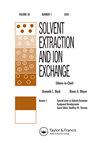The Coordination Chemistry and Stoichiometry of Extracted Diglycolamide Complexes of Lanthanides in Extraction Chromatography Materials
IF 2.1
4区 化学
Q3 CHEMISTRY, MULTIDISCIPLINARY
引用次数: 10
Abstract
Industrial rare earth element (REE) separations predominantly utilize solvent extraction processes tailored toward conventional resources such as bastnäsite, monazite, and ion adsorption clays. Advances in diglycolamide (DGA) chemistry have shown effective extraction characteristics for REE separations. However, limitations associated with traditional DGA solvent extraction techniques, such as third-phase formation and gelling, have hindered commercial viability. By supporting DGA extractants on porous resins such as polystyrene divinyl benzene (PS-DVB), the desirable combination of solvent extraction selectivity and ease of operation of sorbent columns can be achieved. To design a low-cost model for such solid-supported DGAs, extraction characteristics as influenced by the underlying coordination chemistry must be explored to achieve efficient functional systems. Within this study, we report novel DGA resin materials, each incorporating one of the DGAs N,N,N’,N’-tetra-(1-octyl)-3-oxapentane-1,5-diamide (TODGA), N,N′-dimethyl-N,N′-dioctyl-3-oxapentane-1,5-diamide (DMDODGA), and 2,2ʹ-oxybis(1-(3-(((2-ethylhexyl)thio) methyl)-4-methylpyrrolidin-1-yl)ethan-1-one) (DEHPDGA). The affinity of DGAs across the lanthanide (Ln) series was evaluated for both hydrochloric acid and nitric acid media with varying Ln feed concentrations to study distribution ratios and loading characteristics. Focusing on dysprosium, extended X-Ray Absorption Fine Structure (EXAFS) and density functional theory (DFT) calculations were also utilized to explore coordination chemistry and their effects on ligand performance. The general trend for both acid media resulted in DMDODGA having the highest extraction strength of all three DGAs at varying acid concentrations. Coordination-chemistry analysis supported by loading data, DFT calculations, and EXAFS results under forced loading conditions posited less than the expected 3:1 ligand-to-metal coordination.萃取色谱材料中镧系二甘醇酰胺配合物的配位化学和化学计量
工业稀土元素(REE)分离主要利用针对传统资源(如氟碳石、独居石和离子吸附粘土)量身定制的溶剂提取工艺。二甘醇酰胺(DGA)化学的进展已经显示出用于REE分离的有效提取特性。然而,传统DGA溶剂提取技术的局限性,如第三相形成和胶凝,阻碍了商业可行性。通过将DGA萃取剂支撑在多孔树脂上,如聚苯乙烯二乙烯基苯(PS-DVB),可以实现溶剂萃取选择性和吸附剂柱易于操作的理想组合。为了设计这种固体支持的DGA的低成本模型,必须探索受潜在配位化学影响的提取特性,以实现高效的功能系统。在本研究中,我们报道了新的DGA树脂材料,每种材料都含有一种DGA N,N,N',N'-四-(1-辛基)-3-氧杂环戊烷-1,5-二酰胺(TODGA),N,N’-二甲基-N,N′-二辛基-3-氧杂环丁烷-1,5-双酰胺(DMDODGA)和2,2-氧双(1-(3-((((2-乙基己基)硫基)甲基)-4-甲基吡咯烷-1-基)乙烷-1-酮(DEHPDGA)。评估了DGA在镧系元素(Ln)系列中对不同Ln进料浓度的盐酸和硝酸介质的亲和力,以研究分布比和负载特性。以镝为重点,还利用扩展X射线吸收精细结构(EXAFS)和密度泛函理论(DFT)计算来探索配位化学及其对配体性能的影响。两种酸性介质的总体趋势导致DMDODGA在不同的酸浓度下具有所有三种DGA中最高的提取强度。负载数据、DFT计算和EXAFS结果支持的配位化学分析表明,在强制负载条件下,配体与金属的配位小于预期的3:1。
本文章由计算机程序翻译,如有差异,请以英文原文为准。
求助全文
约1分钟内获得全文
求助全文
来源期刊
CiteScore
4.40
自引率
5.00%
发文量
15
审稿时长
8.4 months
期刊介绍:
Solvent Extraction and Ion Exchange is an international journal that publishes original research papers, reviews, and notes that address all aspects of solvent extraction, ion exchange, and closely related methods involving, for example, liquid membranes, extraction chromatography, supercritical fluids, ionic liquids, microfluidics, and adsorption. We welcome submissions that look at: The underlying principles in solvent extraction and ion exchange; Solvent extraction and ion exchange process development; New materials or reagents, their syntheses and properties; Computational methods of molecular design and simulation; Advances in equipment, fluid dynamics, and engineering; Interfacial phenomena, kinetics, and coalescence; Spectroscopic and diffraction analysis of structure and dynamics; Host-guest chemistry, ion receptors, and molecular recognition.

 求助内容:
求助内容: 应助结果提醒方式:
应助结果提醒方式:


